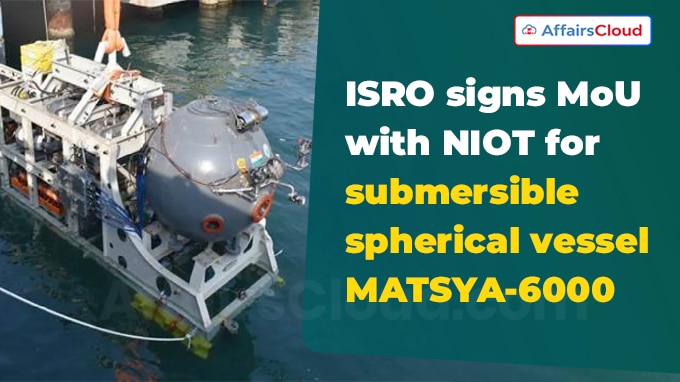 On 23rd July 2025, Vikram Sarabhai Space Centre (VSSC), a centre under the Indian Space Research Organisation (ISRO), signed a Memorandum of Understanding (MoU) with National Institute of Ocean Technology (NIOT), an autonomous institute under the Ministry of Earth Sciences (MoES), for the development of a Human Occupied Vehicle (HOV) named ‘MATSYA-6000’, a submersible vessel under the ‘Samudrayaan project’.
On 23rd July 2025, Vikram Sarabhai Space Centre (VSSC), a centre under the Indian Space Research Organisation (ISRO), signed a Memorandum of Understanding (MoU) with National Institute of Ocean Technology (NIOT), an autonomous institute under the Ministry of Earth Sciences (MoES), for the development of a Human Occupied Vehicle (HOV) named ‘MATSYA-6000’, a submersible vessel under the ‘Samudrayaan project’.
About Samudrayaan Project:
Overview : It is India’s first manned deep-ocean mission and a part of the Deep Ocean Mission led by the MoES.
Aim: To send a three-member crew in a submersible vehicle to explore ocean resources at depths of up to 6,000 metres (m) (6 kilometers, km).
About MATSYA-6000 Submersible:
Design: The submersible features a spherical personnel capsule of 2,260 millimetres (mm) diameter, built using Titanium alloy with 6% Aluminium, 4% Vanadium – Extra Low Interstitials grade (Ti6Al4V – ELI grade), with a wall thickness of 80 mm.
Depth Capability: Designed to withstand pressure up to 600 bar and temperatures as low as -3°C.
Crew: Capable of carrying a three-member crew into the deep sea.
Technological Contributions:
VSSC: Responsible for the design and material development of the personnel sphere.
Liquid Propulsion Systems Centre (LPSC): Developed the infrastructure required for Electron Beam Welding (EBW) and Non-Destructive Evaluation (NDE).
- The EBW machine was upgraded from 15 kilowatt (kW) to 40 kW to support welding of up to 80 mm thickness over a weld length of 7,100 mm.
- Conducted nearly 700 welding trials to fine-tune the process and determine optimal parameters.
Non-Destructive Evaluation (NDE): High-energy X-ray radiography system was upgraded to 7.5 Mega-electronvolt (MeV) to test thick welds.
- Advanced testing techniques such as Time of Flight Diffraction (TOFD) and Dual Linear Array (DLA) Phased Array Ultrasonic Testing (PAUT) were used to assess weld quality.
Testing Timeline:
- The MATSYA-6000 submersible successfully completed its first wet test in October–November 2024 at Chennai Harbour(Tamil Nadu, TN), reaching a depth of 15 m.
- It will undergo shallow-water trials up to 500m in late 2025, followed by unmanned deep-sea tests at its full design depth of 6,000min 2026.
About National Institute of Ocean Technology (NIOT):
Director – Balaji Ramakrishnan
Headquarters – Chennai, Tamil Nadu(TN)
Established – 1993
About Vikram Sarabhai Space Centre (VSSC):
Director – S. Unnikrishnan Nair
Headquarters – Thiruvananthapuram, Kerala
Established – 1963




